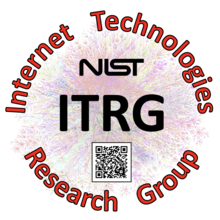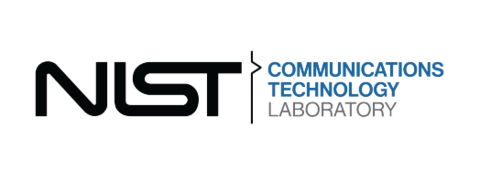Doug Montgomery (Fed)
Manager, Internet Technologies Research Group
Links: douglas.montgomery [at] nist.gov (subject: %5Bweb%5D%20-) (Email), LinkedIn , Twitter, Google Scholar , Research Gate , ORCiD
Position Description:

I manage the Internet Technologies Research Group within the Communications Technology Laboratory (CTL) of the National Institute of Standards and Technology (NIST). In that role I provide technical leadership to NIST's current research and standardization efforts in Trustworthy Networks, including Internet infrastructure Protection (e.g., Naming, Routing, Email and general Internet protocol security); next-generation Internet technologies (e.g., IoT, IPv6, SDN / NFV); advanced security architectures and technologies (e.g., zero trust networks, applications of AI to network security and robustness); advanced security architectures for next-generation wireless (e.g., 5G, O-RAN, 6G); and measurement, modeling, and analysis of behaviors within the critical network infrastructure.
I have been a leader in NIST's research in next-generation network technologies for over 25 years. While the advanced networking technologies under study have spanned a broad spectrum over my career at NIST (e.g., IP quality of service, Internet telephony, Internet security and key management, robust Internet routing / naming / addressing, mobile systems, programmable networks, optical networking, multi-protocol label switching, service discovery, pervasive computing, IP version 6, public safety communications, congestion control, cloud computing, quantum cryptography, zero trust networks, 5G / O-RAN security), the strategic plan has been consistent: to research and apply advanced test and measurement techniques to improve the quality and timeliness of new networking technologies that address identified national priorities and/or have the greatest potential for fueling broad-based innovation in the Internet.
The goals of our Trustworthy Networks Program are tightly aligned with identified national priorities outlined in the National Cybersecurity Strategy and Implementation Plan, National Strategy to Secure 5G, National Standards Strategy for Critical and Emerging Technology Technologies, and Federal Cybersecurity Research and Development Strategic Plan.
The technical work in my group spans a wide range of activities, including basic research, design, and analysis of consensus standards, development of rapid prototypes, reference implementations and test tools for implementors, publication of guidance documents to foster adoption, design, and operation of international conformance and interoperability testing programs to assist deployment.
I serve as the primary external representative for most of these efforts and have represented the work of my group to numerous industry, government, and academic audiences, including congressional committees, inter-agency groups, international governments, VCAT and NRC review panels as well as other agency collaborators. Examples of such interactions include the House Science Committee, Federal CIO Council, Federal CIO, OSTP, NITRD, OMB, ONCD, ONDI, GSA, NTIA, FCC, CSRIC, Internet Engineering Task Force (IETF), North American Network Operators Group (NANOG), American Registry for Internet Numbers (ARIN), O-RAN Alliance, ATIS, ISO/IEC.
I currently serve as co-chair of the NSTC Networking and Information Technology Research and Development (NITRD) Large Scale Networking (LSN) Interagency Working Group and member of the executive committee for the Federal IPv6 Task Force as well as a participant in many other US Government inter-agency committees on networked information technology issues.
My management experience as a group leader at NIST includes managing a staff of computer scientists, electrical engineers, mathematicians, and administrative personnel engaged in a wide variety of research and support tasks. In the time that I have been a manager, the projects and programs in my group have been supported by DHS S&T, NSA, LTS, DARPA, NSF, OMB, GSA, NIST ATP, DISA, NIST NAMT, NIST OLES and NIST IMS research funds.

Technical Interests:
Next generation network technologies, Internet core infrastructure (naming, addressing, routing), 5G / nextG networks core networks, security and resilience of core network infrastructure, measurement and modeling of large-scale networked information systems.
Current Projects:
- The Advanced Security Architectures for Next Generation Wireless project works with mobile wireless, internet and virtual computing industry to improve the security and resilience of emerging designs for 56 / 6G core networks and radio access networks (RANs).
- The Robust Inter-Domain Routing project includes collaborative research with leading Internet companies to design and standardize technologies to improve the resilience and security of the Internet’s global routing system.
- The Zero Trust Networks project seeks to define the basic principles of zero trust architectures and to develop standards and guidance for their implementation in modern enterprise environments and in the core infrastructure of next generation wireless networks.
- The Trustworthy Intelligent Networks project works with industry and academia to improve the trustworthiness and applicability of artificial intelligence and machine learning technologies to future networks and distributed systems.
- The High Assurance Domains project works with the IETF, Messaging Malware Mobile and Anti-Abuse Working Group (MAAWG), Department of Defense and the Federal CIO Council to research and develop new technologies to address key trust and security issues in enterprise networks.
- The Software Defined and Virtual Networks project works to develop test and measurement techniques to advance the state of the art in network virtualization, network service function chaining, software defined networks, technologies and techniques to address robustness and security of virtualized network services.
- The Trustworthy Network of Things project works with industry to design, standardize, test and foster adoption of network-centric approaches to protect IoT devices from the Internet and to protect the Internet from IoT devices.
- The USGv6 Program works with the IETF and Federal CIO community to provide technical leadership in standards profiles, product testing programs, and deployment guidance to foster the global transition to the next generation Internet Protocol (IPv6).
- The Measurement Science for Complex Information Systems project aims to develop and evaluate a coherent set of methods to understand behavior in complex information systems, such as the Internet, computational grids and computing clouds.
Past Projects:
- Internet Protocol Security
- Multi-Protocol Label Switching
- All-Optical Networks
- Programmable Active Services with SIP
Awards
Awards:
- 2025 CTL Award for Outstanding Impact in External Collaboration and Outreach - for contributions of measurement data, analyses and subject matter expertise to the Office of the National Cyber Director's efforts to develop its Roadmap to Enhancing Internet Routing Security.
- 2021 Dept of Commerce Gold Medal - for outstanding contributions in the design, standardization, and widespread deployment of technologies that resolve critical vulnerabilities in the Internet’s routing infrastructure.
- 2021 Dept of Commerce Bronze Medal - for contributions to the design of the NIST publication review system.
- 2020 New Internet IPv6 Hall of Fame - Honored by the IPv6 Forum for leading the USGv6 Program that provides the technical infrastructure necessary to drive USG adoption of IPv6 Technologies.
- 2020 ITL Best Standards Document Award - For excellence in publication of the NIST SP 800-189 standard, “Resilient Interdomain Traffic Exchange: BGP Security and DDoS Mitigation.”
- 2019 Dept of Commerce Bronze Medal - For technical contributions to DoC/DHS effort on Enhancing the Resilience of the Internet and Communications Ecosystem Against Botnets and Other Automated, Distributed Threats.
- 2019 Dept of Commerce Bronze Medal - For leadership in NCCoE public/private collaborations that have advanced the security of national and global network infrastructures.
- 2018 ITL Outstanding Contribution Award - for contributions to design, analysis, standards, prototyping, and measurement of new technologies to improve the Robustness of Internet Inter-Domain Routing.
- 2018 ITL Outstanding Standards Document Award - for design and specification of the BGPsec protocol and leading the publication of the International Standard “BGPsec Protocol Specification,” IETF RFC 8205.
- 2013 Dept of Commerce Gold Medal – Technical leadership in the development of the USGv6 Program fostering wide scale operational deployment of IPv6 in the USG.
- 2011 Dept of Commerce Gold Medal – Technical leadership, in collaboration with NTIA, to deploy DNSSEC at the root of the global DNS.
- 2009 Dept of Commerce Gold Medal – Technical leadership, in collaboration with GSA, to deploy DNSSEC in the .gov Top Level Domain.
- 2008 Federal 100 Award – Technical leadership, in collaboration with OMB, in the transition to IPv6.
- 2008 ITL Best Standards Contribution Award – NIST SP on BGP Security.
- 2007 ITL Best Journal Paper Award – Attack Modeling on the Global Routing System.
- 1993 Dept of Commerce Bronze Medal – Technical leadership in testing frame relay technologies.
And .....
- 2024 NIST Golf League Team Championship - Team "Larry's Leftovers"
- .... it only took 25 years to repeat!
- 1999 NIST Golf League Team Championship - Team "Drain-O"




